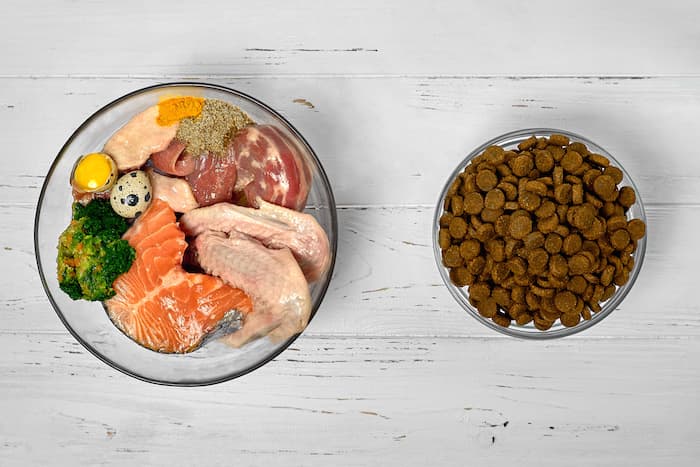Are you tired of feeding your dog the same old kibble? It’s time to explore a new approach to dog nutrition – the raw diet. Raw feeding enthusiasts claim that this natural, unprocessed diet can lead to healthier skin, a shinier coat, and increased energy levels for our dogs. But is it really as good as they say? Let’s dig deeper and find out if the raw diet is a game-changer for our four-legged friends.

What is a Raw Diet for Dogs?
A raw diet for dogs, also known as raw food or BARF (Biologically Appropriate Raw Food), means feeding your dog uncooked ingredients such as bones, raw meat, fruits, and veggies. This approach is based on the belief that dogs have evolved to eat a natural, raw diet similar to their ancestors in the wild.
Advocates claim that feeding dogs a raw diet can lead to various benefits, including improved digestion, healthier teeth and gums, a stronger immune system, and increased energy levels. However, the topic remains controversial, and further exploration is necessary to determine its true benefits.
Nutritional Considerations
When it comes to assessing the nutrient requirements of dogs, it is essential to consider the balance of proteins, fats, and carbohydrates in their diet. A raw dog diet typically consists of uncooked ingredients such as raw meat, bones, fruits, and vegetables. People who favor this approach believe it aligns with dogs’ natural diet as carnivorous animals. They argue that feeding dogs a raw diet can lead to numerous benefits.
However, it is important to note that the debate surrounding the efficacy and safety of raw diets is ongoing. Critics raise concerns about the potential risks of bacterial contamination and nutrient imbalances.
Risks and Challenges of Raw Feeding
While a raw diet for dogs can offer potential benefits, it also comes with risks and challenges. One of the main concerns is the potential for bacterial contamination, as raw meat can contain harmful pathogens like Salmonella or E. coli.
Another challenge is ensuring a balanced diet that meets the dog’s nutritional needs. This requires careful planning and knowledge of the appropriate ratios of proteins, fats, and carbohydrates. Additionally, there is an ongoing debate among veterinarians and experts regarding the long-term effects of a raw diet on a dog’s health. It’s important to consult with a veterinarian and make informed decisions when considering a raw diet for your dog.

How to Start a Raw Diet for Dogs?
To start a raw diet for dogs, it’s important to transition gradually from their current diet. Begin by replacing a small portion of their regular food with raw meat, such as chicken or beef. Over time, increase the amount of raw food while reducing the amount of kibble or canned food. Introduce a variety of proteins like poultry, red meat, and fish, along with organs and bones. Remember to monitor your dog’s health and make adjustments as necessary.
Also, it’s a good idea to include Petz Park probiotic supplements into their diet, which will balance their gut and ensure optimal digestion.
How Much to Feed your Dog with a Raw Diet
When feeding your dog a raw diet, it’s important to consider their unique nutritional needs and adjust the portion sizes accordingly. The amount of food to feed will vary depending on your dog’s age, weight, activity level, and overall health.
A general guideline is to feed 2-3% of your dog’s body weight per day, divided into two meals. For example, if your dog weighs 50 pounds, you would feed them approximately 1-1.5 pounds of raw food daily. Consulting with a veterinarian is crucial to determine the right portion sizes for your dog.
Alternative Approaches to Balanced Nutrition
An alternative approach to balanced nutrition for dogs is high-quality commercial dog food. There are many reputable brands available that offer complete and balanced meals formulated to meet all of a dog’s nutritional needs. These commercial diets undergo rigorous testing and quality control measures to ensure the safety and health of dogs.
Another option is to combine raw and commercial diets. This approach allows for the benefits of raw feeding while still providing the convenience and peace of mind of a commercially prepared diet. It can be achieved by feeding raw meals for some meals and providing high-quality commercial food for others.
A middle ground between raw and commercial diets is cooked food. Some pet owners choose to cook meals for their dogs, using ingredients such as lean meats, vegetables, and grains. This approach allows for greater control over ingredients and cooking methods while still providing dogs a balanced and nutritious diet.
Related Reading
